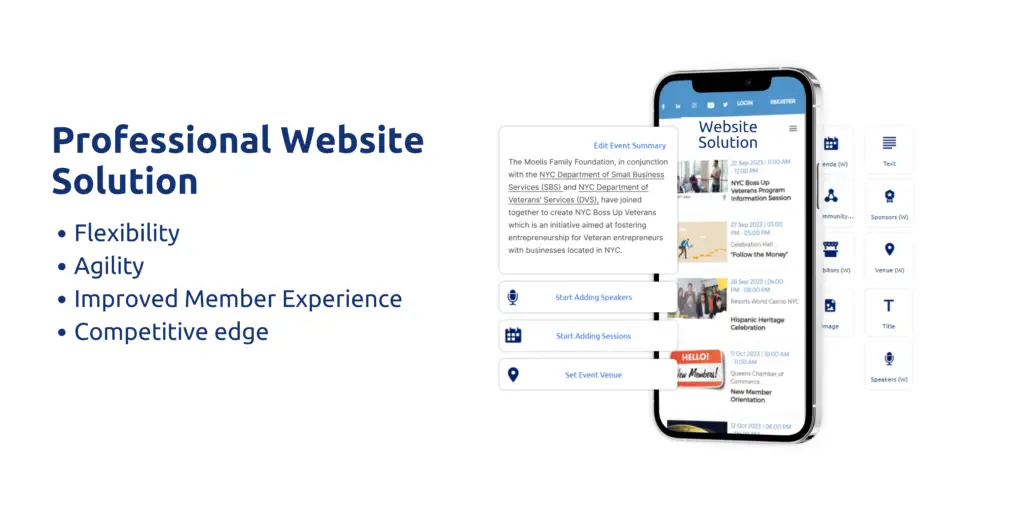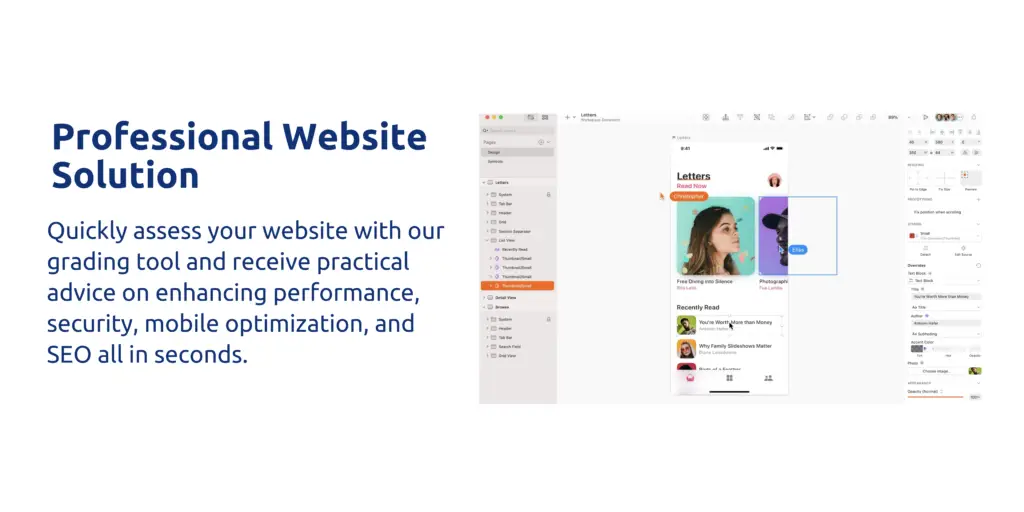Establishing a strong online presence is now an absolute must for business success. By maintaining and tracking the numerous layers of strategy, identity, and technical infrastructure of a well-built professional website solution, you can leverage this normal physical media to convey the true meaning behind the brand to put the audience in a trance. That is a breakdown of what this web solution should be.
Also mentioned here: Professional Website Solution
Domain Name Registration: Claiming Your Digital Territory
Domain call registration secures a unique Internet address (URL) for your website. Securing your unique domain name is like planting your flag on raw cyberspace land. This is an important step of tactical securing a unique URL according to one’s vision and identity. Here’s how you can register a website name.
Choose a Domain Registrar
Choose a good area registrar to register your area name. Popular area registrars include GoDaddy, Namecheap, Hostinger, Google domain names, and Bluehost. Evaluate pricing, features, customer service, and user reviews before selecting a registrar.
Check Domain Availability
Use the area search device provided by the registrar to check the availability of your favored domain name. Input the area name you need to sign in (e.g., “yourbusinessname.com”) to see if it is available. If the domain is unavailable, strive for exceptional variations or consider opportunity extensions (.net, .org, .biz, etc.).
Choose a Domain Extension
TLDs (top-level domains) are more than suffixes: they are heuristics. .com is still standard, while .io, .biz, and the various regional TLDs (.ca, .co, .uk) indicate specificity. Use one that holds a certain resonance with what your company is communicating.
Register the Domain
Once you’ve discovered an available area name that satisfies you, continue to check it through the registrar’s website. Comply with the registrar’s instructions to finish the registration procedure, supplying your contact information, fee information, and any extra offerings you may want (e.g., privacy protection, area forwarding).
Review Registration Details
Review the registration details cautiously before finishing the registration process. Double-test the spelling of the area name, the chosen domain extension, and the registration period (typically 1 year or longer). Make sure that your facts are accurate.
Complete the Payment
Pay the registration charge using the favored payment method with the aid of the registrar (e.g., credit card, PayPal). The registration rate might also vary depending on the registrar, the domain extension, and any extra offerings you’ve selected.
Manage Your Domain
After effectively registering your domain name, get access to the registrar’s domain control dashboard to view and control your domain settings. You can replace touch statistics, renew your area registration, permit domain privacy, and configure DNS settings as needed.
Renew Your Domain
Domains need to be renewed periodically to hold possession and avoid expiration. Installation vehicle-renewal or manually renew your area registration earlier than the expiration date to keep away from dropping your domain name.
Protect Your Brand
Recall registering a couple of area extensions or variations of your domain name to shield your brand and prevent competition from registering similar domain names. You could additionally remember shopping for domain privacy protection to preserve your contact records.
By following these steps, you may correctly sign up for a site name for your website and set up your online presence with a unique web address. Remember to pick a memorable and brandable domain name that displays your business identification and resonates with your audience.
The Web Hosting: Your Digital Fortress Earth
Website hosting is a service that lets people and organizations make their websites available via the Internet. Right here’s how it works.
Select a Hosting Provider
Pick a reputable web hosting company that offers the functions you want for your website. Take into account factors like reliability, speed, protection, customer service, and pricing while deciding on a web hosting provider.
Choose a Hosting Plan
Pick a website hosting plan that suits your website’s needs. Common varieties of web hosting plans consist of shared website hosting, VPS (virtual private Server) website hosting, dedicated website hosting, and cloud hosting. Every form of hosting plan offers specific stages of resources, control, and scalability.
Register a Domain Name (if needed)
Additionally, if you’re looking to secure a domain for your website, you can explore options through your hosting provider or a dedicated domain registrar. Furthermore, several web hosting companies offer domain registration services as a component of their packages.
Set Up Your Hosting Account
Sign in for a web hosting account with your selected provider and complete the registration process. You will normally need to provide your contact information, pick a web hosting plan, select any additional services, and install billing details.
Domain Integration (If Not Pre-Bundled)
If you have purchased your domain and hosting separately, link them together by modifying the DNS settings. Use nameservers as recommended by your host to perform this linking.
Upload Your Website Files
Once your web hosting account is set up and your area is pointed to the website hosting server, you can upload your website documents to the server. This usually includes the use of an FTP (File Transfer Protocol) client or an internet-primarily based document manager provided using your web hosting manipulate panel to transfer files from your local PC to the server.
Configure Email Accounts (if needed)
In case your hosting plan includes email and website hosting, you can set up email related to your domain. Use the hosting management panel to create email addresses, set up email forwarding, configure email filters, and manipulate other email settings.
Manage Your Hosting Account
Use the website hosting control panel furnished by your hosting provider to manage diverse factors of your website hosting account. This can encompass coping with domain settings, configuring server settings, tracking the website’s overall performance, and having access to help sources.
Regular Maintenance
Often, reveal and preserve your hosting account to ensure the most effective overall performance, safety, and reliability. This will involve installing software program updates, backing up your website documents and databases, monitoring server sources, and addressing any safety vulnerabilities or overall performance troubles.
Scale as Needed
As your website grows and your website hosting needs evolve, you may need to upgrade or modify your hosting plan. In this case, many website hosting providers offer scalability options that can help you seamlessly enhance your resources or switch to a dedicated hosting plan when necessary.
By following those steps, you can install hosting on your website and make your website accessible to site visitors on the internet. Pick a reliable hosting provider and plan that meets your requirements and finances, and often reveal and hold your hosting account to ensure the overall performance and safety of your website.
Website Design
Website design encompasses the look, format, and personality of a website. Here’s a step-by-step guide for growing a nicely designed website.
Outline your Dreams and Target Audience
Firstly, you should begin by designing the digital persona of your brand. Then, research who your supposed users are. Finally, create a narrative and unique design for your website that represents your brand.
Plan Your Website Structure
Firstly, create a website map outlining the shape and hierarchy of your website’s pages. Additionally, set up your content logically, and don’t forget to interlink the individual’s journey from landing on your homepage to navigating through other pages.
Choose a Platform and Hosting
Pick a website platform that suits your requirements and technical capabilities. Some famous platforms include WordPress, Wix, Squarespace, and Shopify. Next, choose a dependable website hosting company to ensure your website performs properly and is available to visitors.
Select a Template or Theme
Pick a pre-designed template or theme that aligns with your brand identity and website dreams. Customize the template to fit your branding, such as hues, fonts, and imagery.
Create Engaging Content
You should create content for your website by including textual content, pictures, videos, and multimedia elements. Also, focus on writing a clear and concise replica that communicates your message efficiently to your target audience.
Design the Layout and Navigation
Design the layout of your website, including headers, footers, and navigation menus. Ensure the navigation is intuitive and smooth to use, allowing customers to find statistics rapidly and navigate among pages seamlessly.
Consciousness of Cellular Responsiveness
Make it mobile responsive in the website layout. By doing so, it will look and perform properly on devices of all sizes, including smartphones and tablets. Additionally, use responsive layout techniques to evolve your layout and content for exquisite screen sizes.
Optimize for Overall Performance and Search Engine Optimization
Optimize your website for overall performance and SEO (search engine optimization). Enhance web page loading instances, optimize photographs, and use SEO practices to enhance your website’s visibility in search engine results.
Test and Iterate
Test your website on various browsers, devices, and display sizes to ensure compatibility and usability. Furthermore, collect feedback from users and make iterative improvements to your design based on their input.
Launch Your Website
After you’re satisfied with your website design, launch it for the public. Monitor its performance and personal remarks, and retain to make updates and refinements as needed.
Frequently maintain and update your website to ensure it remains cozy and purposeful. Preserve your content sparkling and applicable. Often, evaluate your layout and overall performance metrics to stay up-to-date and identify areas for improvement.
Maintain and Update Regularly
With those steps and principles of desirable layout, you can create a well-designed website that successfully communicates your message, engages your target audience, and achieves your desires. Up-to-date operations with expert designers or groups will ensure your website design meets the best standards and aligns with your updated logo identification.
You may also like to read: Various Survey Practices for Webinars & Events

Content Management System (CMS)
First and foremost, pick out a CMS platform that fits your technical necessities and content management preferences. Additionally, consider the famous CMS options, which include WordPress, Joomla, Drupal, and Squarespace. These all provide exceptional features and functionalities.
Themes and Templates
CMS systems provide a range of pre-designed themes and templates that users can choose from to change the look and experience of their website. Issues often come with customizable color schemes, font alternatives, format patterns, and web page templates.
Drag-and-Drop Editors
Many website developers feature drag-and-drop editors that allow users to rearrange web page elements. In addition, users can add new sections and customize the layout of their website without writing any code. Furthermore, you can drag elements like textual content boxes, snapshots, buttons, and widgets onto the page and position them as desired.
Custom Branding
Customers can add their emblem, emblem colors, and imagery to personalize their website and align it with their brand identification. Custom branding options permit regular branding throughout all pages and elements of the website.
Font Customization
CMS structures and website builders regularly provide options for customizing typography, along with font styles, sizes, and weights. Users can select from the available fonts or upload custom fonts to shape their emblem’s aesthetic.
Custom CSS and HTML
For customers with cointegrating knowledge, CMS systems normally permit custom CSS and HTML to be built in addition to customizing the appearance and functionality of the website. It gives us a full-range infrastructure to set up an advanced CMS for further customization beyond the other existing alternatives.
Widgets and Plugins
CMS systems provide an extensive range of widgets and plugins that you can deploy to add more features to their websites. These can also encompass contact forms, social media feeds, e-trade integrations, event calendars, and more.
Navigation Menus
Users can customize navigation menus to arrange website content and improve site navigation. Options may include developing dropdown menus, including custom links, and arranging menu gadgets in a specific order.
Page Layouts
CMS systems frequently allow customers to create custom page layouts by deciding on unique column configurations, adding content blocks, and adjusting the spacing and alignment of page elements.
Mobile Responsiveness
Website builders and CMS structures ensure that websites are mobile-responsive by default. However, users can frequently customize the layout to optimize the consumer experience on smartphones and tablets.
Accessibility Features
Some CMS systems provide accessibility features or plug-ins that allow customers to make their websites more accessible to customers with disabilities. This may include options for including alt textual content to photos, a built-in proper heading structure, and integrated keyboard navigation.
By taking built-in integrated customization options, customers can create unique and visually built websites that meet their precise requirements and efficiently establish their brand online.
Responsive Design
Make sure that your website is mobile responsive and satisfies the users. It will give a seamless experience to everyone, irrespective of the device or screen size. Responsive design improves usability, SEO ratings, and personal engagement on smartphones, tablets, and computers.
SEO Optimization
You can enforce SEO techniques to enhance your website’s visibility and ranking in search engine results. Furthermore, optimize on-page elements, metadata, key phrases, and content to attract organic visitors and grow online visibility.
Security Measures
Implement security measures to defend your website from cyber threats, malware, and unauthorized access. In addition, install SSL certificates, use secure passwords, regularly update software programs, and back up your website data to prevent security breaches and data loss.
E-commerce Functionality (if applicable)
If you plan to promote services or products online, integrate e-trade capability into your website. Choose an e-commerce platform that includes WooCommerce, Shopify, or Magento to manipulate product listings, transactions, payments, and shipping.
Analytics and Tracking
Install a website analytics tool with Google Analytics to track visitors’ behavior, display website performance, and accumulate insights into consumer demographics, visitor resources, and engagement metrics. Use the information to improve your website and advertising strategies.
Social Media Integration
Combine social media buttons, sharing alternatives, and feeds into your website to inspire social sharing, interplay, and engagement. Connect your website to your social media profiles to amplify your online presence and connect to your target market.

Regular Maintenance and Updates
Regularly hold and replace your website to ensure top-of-the-line performance, security, and capability. Perform routine backups, software updates, security scans, and content revisions to keep your website running smoothly.
Wrapping Up
By incorporating those elements into your expert website answer, you could create an effective online platform to exhibit your logo. In addition, this will help attract clients and achieve your business objectives effectively. Moreover, partner with experienced website designers, builders, and virtual marketers to create and maintain a website that grants outcomes for your enterprise.







